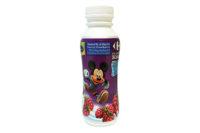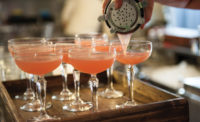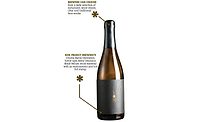Although it’s important to consider the end-consumer when choosing a labeling material, beverage-makers also need to look at the larger labeling picture and their teams’ abilities, advises Lou Iovoli, vice president of strategic partnerships for Hammer Packaging, Rochester, N.Y. “You’ve really got to define your bottle, your packer and the labeling line options,” he says. “Develop a flow chart so you can understand from start to finish what your package is going to be, who’s going to be filling the package, what equipment they have that they can use to fill that package, and, in that same flow chart, … define what your package is going to be.”
For example, labeling material selection can be limited by the use of a specific co-packer, Iovoli says. The type of equipment the co-packer has in stock determines what labeling means are available for use, he says.
The type of packaging used, whether aluminum cans, glass bottles or polyethylene terephthalate (PET) bottles, also limits the types of labeling materials that can be used, Iovoli says. Although fewer options are available for cans, most labeling types are suitable for glass and PET bottles, he says.
The gauge of the packaging material also can be a determinant in labeling material selection, says Jyl Gryder, marketing manager of SleeveCo Inc., Dawsonville, Ga. The trend of lightweighting packages has led many beverage-makers to opt for shrink-sleeve labels to stabilize the total package, she says.
In addition, the package’s shape needs to be taken into account when selecting a labeling material. For straight-walled containers, roll-fed, cut-and-stack, and pressure-sensitive labels can all get the job done, according to David Niemuth, director of labeling technology for Krones Inc., Franklin, Wis. However, for contoured packages or packages with unique shapes designed to aid in shelf differentiation, shrink-sleeve labels are needed, he says.
Through the use of automatic applicators and steam tunnels, shrink-sleeve labels shrink to conform to the shape of a container, explains Jim Mallon, vice president of sales and marketing for MRI Flexible Packaging, Newtown, Pa. These labels also offer 360-degree, high-gloss graphic coverage through reverse printing on clear film and can include tamper-evident features, he says. In addition to custom-shaped containers, shrink sleeves also are suitable for wrapping multi-pack containers, he adds.
These features are helping to propel shrink-sleeve labels as the fastest-growing label type, according to The Freedonia Group Inc., Cleveland. The business research firm charted 5 percent average annual demand growth for heat-shrink and stretch-sleeve labels combined from 2007 to 2012, and it projects 5.3 percent annual average demand growth for these labels through 2017.
Printpack Inc., Atlanta, offers its Ecoskin full-body shrink sleeve material with up to 60 percent shrink to conform to a broad range of container styles, the company says. The low-density polyolefin film offers an eco-friendly solution because it floats in a wash water PET recycling stream and meets The Association of Postconsumer Plastics Recyclers guidelines, says James Taylor, business development manager for Printpack US.
Merging shrink-sleeve technology with another label type, Fort Dearborn recently introduced shrinkable cut-and-stack labels for custom-shaped containers as well. With an oriented polypropylene (PP) film structure, the labels are composed of as much as 15 percent shrink and overcome the challenges of traditional cut-and-stack labels that are usually restricted to straight-walled packages, the company says. Because this label is cut-and-stack, beverage-makers can use existing cut-and-stack label application equipment to apply the labels and then use a dry-heat tunnel to shrink them, it adds.
Although cut-and-stack labels might previously have been limited in their uses, the technology for working with cut-and-stack labels is well established, and labelers can work with this label type at very high speeds, Hammer’s Iovoli notes.
Another labeling material option for covering uniquely shaped containers is stretch sleeves. Like shrink sleeves, stretch-sleeve labels are able to follow the shape of a container but without a need for heat, explains Alcyr Coelho, vice president of sales and marketing for PDC-Europe (Americas) Inc., Austin, Texas. As a result, this method of label application can offer as much as 95 percent energy savings compared with shrink-sleeve applicators, he says. In addition, this labeling material is typically 30 to 50 percent less expensive than shrink sleeves, he adds.
MRI Flexible Packaging recently released its C-Fit Sleeve film labels for stretch-sleeve applications. Because it does not require any glue for application, the C-Fit Sleeve can be easily removed from the package for container reuse, the company says. In addition, the label has a specific density of less than 1 gram, enabling it to float on water in a wash water recycling stream for easy separation from PET, it adds.
After determining the crucial factors of packaging shape, type and co-packer, a beverage-maker needs to determine what labeling material objectives are most important for a given project and work from there, SleeveCo’s Gryder advises. “The best tip I can give is to be clear on what goals you wish to achieve with your label in the planning stages of the project,” she says.
Connecting with consumers
Once a label is completed and on the store shelf, its most important job is to connect with consumers, says Don Earl, president of Overnight Labels Inc., Deer Park, N.Y. “The label is the final message conveyed to the consumer,” he explains. “It ties the whole marketing message together. It identifies the product. The label helps create the buying mood and is the source of all the nutritional information. You can’t sell a product without it.”
Through the use of color, shape and interactive elements, labels help to provide shelf differentiation for products and help them stand out in a crowded marketplace, adds Gwen Chapdelaine, marketing director for Fort Dearborn Co., Elk Grove, Ill. For example, some brands can opt for a clear label to give their brand a no-label, upscale look to showcase quality and health and wellness attributes, she says.
Other brands might opt for shrink sleeves or roll-fed non-shrink label films because they give packages a 360-degree billboard space for graphics and information to catch the consumers’ eyes, PrintPack’s Taylor adds.
Additional elements can be added to labels to interact with consumers from the shelf and after purchase, Hammer’s Iovoli says. For example, labelers can add elements like scratch-off panels, specialty inks and coatings, or content on the back of a label to create contests right on the bottle to drive purchases and brand engagement, he says. However, beverage-makers have to consider how their product will be displayed on the shelf or in the cooler, he notes. If bottles are sold individually, consumers might interact with the package prior to purchase in order to find a winning bottle, which takes away from the desired effect, he explains. However, if the bottles are sold in a shrink-wrapped case such that the label can’t be tampered with prior to purchase, these interactive elements can be preserved so that consumers can enjoy them after purchase, he says.
Pulling digital technology into the mix, Wright Labels, a division of Wright Global Graphics Solutions, Thomasville, N.Y., launched a RetailLive program to help consumers interact with companies through product labels. The interactive sales tool allows consumers to use their smartphones to scan key images on printed product labels and point-of-purchase materials to download videos, promotional sales and other virtual content from the company. “Imagine transforming a printed label into a fully interactive experience — one that deepens the connection between your product and the consumer, thereby building and shaping brand loyalty,” said Don Wright, senior vice president of business development and chairman of the board, in a statement. “Research shows that mobile advertising, which currently runs approximately 3.6 billion interactions, will swell to a staggering 18.5 billion interactions by 2015. RetailLive gives our clients an edge by providing consumers with a completely dynamic, interactive and informative shopping experience.” This additional dimension of information can help assist consumers with their purchase decisions by putting product and brand information in the palms of their hands, the company adds.
Presentation and performance
Another important element to consider is how the consumer will use the package after they purchase it, which will then determine the functionality of the labeling material, Fort Dearborn’s Chapdelaine says. “When selecting a label material, customers need to consider the product environment and usage conditions,” she says. For example, for packages often placed by consumers into personal coolers or other wet environments, film-based labels are popular due to their durability and moisture resistance, she explains.
Wet-strength papers also are an option in these situations, Hammer’s Iovoli notes. “Wet-strength papers allow people to put their packages into ice baths and get a certain number of hours before that label will start to degrade,” he explains.
Bennington, N.H.-based Monadnock Paper Mills Inc. released in April an uncoated wet-strength paper label designed for craft beers. The Monadnock Envi label is made from 100 percent Forest Stewardship Council-certified, post-consumer waste fibers and withstands challenging print images, bottling lines and cold, wet coolers, the company says.
“For an uncoated, textured feel, there was always a trade-off,” said Tim Boyd, market segment manager for Monadnock, in a statement. “If you wanted a label to stand up to submersion and not peel, disintegrate or fall off, you had to sacrifice by using mostly virgin pulp. Conversely, if you wanted to be eco-conscious, there was always a compromise in how that material would stand up in the print process or in the cooler. Now, you can have the best of both worlds.”
Because of its ability to be coated for enhanced durability in wet environments, paper is expected to account for the majority of label stock between now and 2017, according to The Freedonia Group.
Overall, the market research firm predicts that label demand will climb 4.2 percent annually to $19.1 billion in 2017, further showing the importance of labels in the overall beverage chain.







